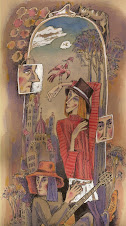The Heart and Craft of Lifestory Writing
--------------------------------------------------------------------------------
Q & A About Keeping a Journal
Posted: 15 Aug 2010 11:02 AM PDT
Journaling is one of the most intensely personal activities you can indulge in and one of the most powerful self-care ones, plus it's a gold mine of material for memoirists. Because it is so personal, there is no right way to do it, but many beginners still have questions. Below are a few of the most common.
Do I have to write by hand?
No. There is some evidence that writing by hand slows your thinking to an orderly pace, giving meditative-like benefits, but the edge is slight. If you are able to catch the gush of your thoughts better on a keyboard, go for it.
How should I choose a journal?
It doesn’t matter if you use a hand-bound volume covered in Italian leather, a composition book from the Dollar Store, a folder full of loose paper, software like LifeJournal. or a basic text editor. What does matter is that you choose something you feel comfortable with, and then use it.
When is the best time to write?
Many people prefer to write first thing in the morning, but that doesn’t work for everyone. Write when you can — during coffee or lunch breaks at work, on the bus, after dinner ...
How often should I write?
To get the most meaningful results, you should write at least several times a week. In her multi-million copy best-seller The Artist’s Way, Julia Cameron advises writing three pages, first thing, every day, and millions of people around the world follow this advise. She does not specify page size. If you skip a day or few for whatever reason, Just pick it back up and keep going as soon as you can.
How much time should I spend?
As stated above, Julia recommends three pages. That may take ten minutes or an hour. Write for as long as you feel the urge and have the time.
What should I write about?
Anything at all. You can keep a log of the weather, record your comings and goings, rant and rave. You can keep a gratitude journal. One key to using it for enhanced health and enlightenment is to focus on feelings, emotions and reactions. The more you get your inner thoughts on paper, the more self-aware you become, the more alternate perspectives you’ll find, and the more stress you are likely to relieve.
Should I share my journal?
That’s a personal choice. If you think others might read it, you’ll filter what you write. You’ll gain the most insight if you keep it private. Hide it or keep it elsewhere if you don’t trust people you live with. Then always write the Truth as you know it, and watch that Truth transform.
What other tips should I know?
Two key questions have generated huge pay-offs of insight for me: “Is this true?” and “What can I learn from this?” After I write one of those questions on the page, I just write down the answer without serious thought. Writing dialogue with people from the past — or even imaginary people — is also powerful for surfacing hidden thoughts and wisdom.
Another tip is to write as fast as you can without concern for punctuation, grammar or even making sense. Just get it on the page and don't let your inner critic stop you!
Do I need lists of topics to write about?
No. But using them can seed some amazing essay material.
What if I lapse?
My advice about writing in your journal is the same as writing life stories: Anything you write, anything at all, is better than writing nothing. Even if it is just a few paragraphs a couple of times a year.
Where can I find more information?
My favorite websites about journaling:
International Association for Journal Writing
Writing Through Life
Center for Journal Therapy
My favorite books about journaling:
One to One, Christina Baldwin
Journal to the Self, Kathleen Adams.
Write Now: if you don’t have a journal, find some paper or open a new file and start one. If you do have one. pull it out and write an entry.
Showing posts with label The Heart and Craft of Lifestory Writing. Show all posts
Showing posts with label The Heart and Craft of Lifestory Writing. Show all posts
Sunday, August 15, 2010
Wednesday, December 30, 2009
From Sharon Lippincott's Blog
The Heart and Craft of Lifestory Writing
--------------------------------------------------------------------------------
New Year's Resolutions Don't Have to Be a Joke
Posted: 28 Dec 2009 05:50 AM PST
Are you one of the majority of readers who will be making New Year's resolutions in the next day or two? Perhaps some of those will include resolutions about writing. Maybe you'll resolve to journal every day. Maybe you'll resolve to complete a memoir, or write a story a week. Whatever your resolutions, here's a tip to help make them bear fruit:
Commit to it publicly and create a time-linked Action Plan to go with each step. I am resolving to complete my Los Alamos Years memoir by January 1, 2011. Here is the Action Plan I just knocked out in about ten minutes I've had a lot of practice writing Action Plans, and I've completed several book projects, so I could do it faster. Perhaps mine will give you an idea what to include in your own.
Sharon's Action Plan for The Los Alamos Years
1-1-2010
Write a draft overview of the story.
1-14-2010.
Define purpose and audience
Write philosophy of story. What message do I plan to convey?
Break overall story into segments — these will probably become chapters.
Survey all the vignettes I’ve already written and select which to include.
Sort vignettes and align with segments.
3-1-2010
Determine what additional stories need to be included.
Select photos for inclusion
Write drafts of each chapter (add additional level to this action step when structure is defined).
Develop scenes.
Polish description, dialogue and detail.
10-1-2010
Send draft around to three or four trusted people for proofing and editing.
11-15-2010
Incorporate feedback from beta readers.
Insert photos and other graphics.
Finalize Title.
Format for printing.
Convert to PDF.
12-7- 2010
Create Cover.
12-15-2010
Upload to (CreateSpace) for PDF and eBook distribution.
Notice that I did not put dates on every single step. Some of these will be done "out of order." Some dates may slip and some may be met early. I'll print my table and put it -- somewhere here where I can see it even with the clutter that tends to build up around my desk -- so I can see it often and be reminded of my commitment. The table will grow as I refine the plan.
By the way, this is not a totally new project idea for me. I've been nibbling at it, dancing around it, for two or three years, and writing vignettes for nearly a dozen. I'm not starting from scratch. But I don't think it would matter. The steps remain the same, and will look familiar to anyone who has seen the Planning Diagrams in the first chapter of my book.
Write now: write a resolution of your own. It may be as simple as writing a single vignette, or journaling every day for a week. But take the time to put it in writing and create an Action Plan, however simple.
Coach Sherrie says: Sharon Lippincott had this Action Plan formatted nicely but it didn't come out here. Sorry!
--------------------------------------------------------------------------------
New Year's Resolutions Don't Have to Be a Joke
Posted: 28 Dec 2009 05:50 AM PST
Are you one of the majority of readers who will be making New Year's resolutions in the next day or two? Perhaps some of those will include resolutions about writing. Maybe you'll resolve to journal every day. Maybe you'll resolve to complete a memoir, or write a story a week. Whatever your resolutions, here's a tip to help make them bear fruit:
Commit to it publicly and create a time-linked Action Plan to go with each step. I am resolving to complete my Los Alamos Years memoir by January 1, 2011. Here is the Action Plan I just knocked out in about ten minutes I've had a lot of practice writing Action Plans, and I've completed several book projects, so I could do it faster. Perhaps mine will give you an idea what to include in your own.
Sharon's Action Plan for The Los Alamos Years
1-1-2010
Write a draft overview of the story.
1-14-2010.
Define purpose and audience
Write philosophy of story. What message do I plan to convey?
Break overall story into segments — these will probably become chapters.
Survey all the vignettes I’ve already written and select which to include.
Sort vignettes and align with segments.
3-1-2010
Determine what additional stories need to be included.
Select photos for inclusion
Write drafts of each chapter (add additional level to this action step when structure is defined).
Develop scenes.
Polish description, dialogue and detail.
10-1-2010
Send draft around to three or four trusted people for proofing and editing.
11-15-2010
Incorporate feedback from beta readers.
Insert photos and other graphics.
Finalize Title.
Format for printing.
Convert to PDF.
12-7- 2010
Create Cover.
12-15-2010
Upload to (CreateSpace) for PDF and eBook distribution.
Notice that I did not put dates on every single step. Some of these will be done "out of order." Some dates may slip and some may be met early. I'll print my table and put it -- somewhere here where I can see it even with the clutter that tends to build up around my desk -- so I can see it often and be reminded of my commitment. The table will grow as I refine the plan.
By the way, this is not a totally new project idea for me. I've been nibbling at it, dancing around it, for two or three years, and writing vignettes for nearly a dozen. I'm not starting from scratch. But I don't think it would matter. The steps remain the same, and will look familiar to anyone who has seen the Planning Diagrams in the first chapter of my book.
Write now: write a resolution of your own. It may be as simple as writing a single vignette, or journaling every day for a week. But take the time to put it in writing and create an Action Plan, however simple.
Coach Sherrie says: Sharon Lippincott had this Action Plan formatted nicely but it didn't come out here. Sorry!
Subscribe to:
Posts (Atom)









